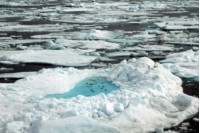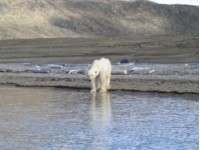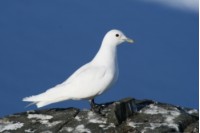The summer ice is disappearing
Why?
The sea ice is disappearing partly because the sea and the climate are getting warmer, and the rise in temperature in the Arctic really moves apace when the ice disappears and there is open sea. Open sea and land absorb a great deal of solar energy and are quickly heated. This heating helps to steadily reduce the snow and ice, and more energy is continuously being absorbed. The heating is a self-energising effect, and steadily increases as the ice melts. This is one reason why the Arctic is now warming much faster than the rest of the world.
 A flock of kittiwakes bathing in a meltwater pool that has formed in the sea ice. Kittiwakes nest in colonies along the coast. They often seek food in flocks, and the food is taken on or just beneath the surface while they are flying or sitting on the sea. Kittiwakes also seek food in ice-filled waters and in upwelling zones in front of glaciers where fresh meltwater meets sea water. They use meltwater pools in the sea ice for recreation and for drinking water.
Illustration: Andrea Taurisano, NPI
Satellites have monitored ice distribution in the Arctic since the 1970s and have pro-vided a much more detailed picture of the annual extent of the ice. It can therefore be stated with certainty that great changes have occurred in recent years. However, it is not just the extent that has changed, the type of ice is also different, and the ice is thinner.
A flock of kittiwakes bathing in a meltwater pool that has formed in the sea ice. Kittiwakes nest in colonies along the coast. They often seek food in flocks, and the food is taken on or just beneath the surface while they are flying or sitting on the sea. Kittiwakes also seek food in ice-filled waters and in upwelling zones in front of glaciers where fresh meltwater meets sea water. They use meltwater pools in the sea ice for recreation and for drinking water.
Illustration: Andrea Taurisano, NPI
Satellites have monitored ice distribution in the Arctic since the 1970s and have pro-vided a much more detailed picture of the annual extent of the ice. It can therefore be stated with certainty that great changes have occurred in recent years. However, it is not just the extent that has changed, the type of ice is also different, and the ice is thinner.
On the basis of the changes that have already occurred, scientists use climate models to predict what will occur in the future. The results show that the Arctic may become ice-free in summer between 2070 and 2100, i.e. in about 60 to 90 years, but in view of the rapid melting that has been observed in the last few years, some scientists now think that the Arctic Ocean will be ice-free far sooner.
Another factor that contributes to ice melting is the occurrence of soot. Soot particles enter the air when such materials as fossil fuels or biomass are incompletely burnt, and they accompany the airstreams to the Arctic, where they land on the ice. The white snow reflects most of the sun's rays, but when it is darkened by soot particles it absorbs more warm rays and therefore melts more rapidly on the surface, too.
Did you know...
 Openings in the sea ice that are larger than 10 km2 are called polynya. This is a Russian word which has been adopted into Norwegian and English because these languages did not have an adequate word. A polynya may form because wind and ocean currents drive the ice away so that the area has no chance to freeze, or it may also be formed by warm water flowing up from depth so that the surface water never reaches freezing point.
Openings in the sea ice that are larger than 10 km2 are called polynya. This is a Russian word which has been adopted into Norwegian and English because these languages did not have an adequate word. A polynya may form because wind and ocean currents drive the ice away so that the area has no chance to freeze, or it may also be formed by warm water flowing up from depth so that the surface water never reaches freezing point.
What is taking place?
The sea ice is very important for life in the Arctic, and also for the physical environment. Sea ice forms from frozen seawater. When the ice freezes, the salt separates out along brine channels, and the actual ice consists almost solely of fresh water. During the winter, snow falls on the ice and a large reservoir of frozen fresh water forms. When the fresh ice melts, the lighter fresh water forms a lid above the heavier salt water. Like the fresh water from glaciers and rivers, this can cause the circulation in the ocean to change, and should extreme melting take place the ocean currents may change.
The sea ice is important for most organisms in the Arctic. Plankton production is especially active near the ice margin and it influences all life in the area. Less sea ice may be favourable for plankton which live in the open water masses. However, there are bio-chemical differences between the ice algae and the plankton in the open sea; ice algae have a higher content of polyunsaturates, which are important for the organisms which live on ice algae. A change in their diet may therefore give less energy yield and poorer ability to survive, grow and reproduce, and a reduced ability for survival will be transmitted up the food chain and may affect populations of fish, birds and mammals.
 A polar bear that has been confined to land has limited possibilities for finding food. Stories are sometimes told of polar bears which have eaten snowmobile seats in summer, broken into huts, or in extreme cases attacked people, either out of curiosity or because they were starving. Hungry polar bears are often dangerous. This bear was clearly emaciated after spending a summer on land, but it had not given up and was very aggressive towards the scientists who happened to be in the vicinity.
Illustration: Kit Kovacs, NPI
A polar bear that has been confined to land has limited possibilities for finding food. Stories are sometimes told of polar bears which have eaten snowmobile seats in summer, broken into huts, or in extreme cases attacked people, either out of curiosity or because they were starving. Hungry polar bears are often dangerous. This bear was clearly emaciated after spending a summer on land, but it had not given up and was very aggressive towards the scientists who happened to be in the vicinity.
Illustration: Kit Kovacs, NPI
However, it is the large mammals which may experience the melting of the sea ice as a disaster. That is where they find their food, give birth to their young and find places to rest. The ringed seal is particularly dependent upon the ice, especially land-fast ice, to be able to maintain its mode of living. It brings forth its pups in cavities which it excavates in the snow above its breathing hole. The pups weigh only 3-4 kg at birth and without their protective cavities, many will fall prey to predators like polar bears, Arctic foxes and glaucous gulls.
Most of the ringed seals that are going to pup live in the fjords around Svalbard, on fast ice that is attached to land or glaciers. This is the only species of seal that excavates breathing holes in the ice and therefore has access to large areas beneath the ice which other mammals cannot reach. If the ice disappears, it will have to compete with the other species for habitats and food, and pup mortality will rise dramatically without the ice.
The polar bear has become the very symbol for climate change in the Arctic, and not without good reason. It generally lives its entire life in the sea ice, and the ringed seal is its favourite dish. So when the ringed seal gets problems, the polar bear gets them too. Polar bears mostly follow the ice edge northwards in summer, finding sufficient food there to survive a long winter when little food is available. Bears which stay on land in summer find little food there and must wait for the ice to form again in the autumn to enable them to build up their reserves for the winter. A female polar bear needs to gain some 200 kg during the summer to survive the autumn and winter in her den with her cubs.
 The ivory gull is one of the seabirds we know least about on the world scale. The global breeding population is estimated to be about 8 000 - 15 000 pairs, 80 % of which are assumed to be in Russia. There is no reliable estimate for the Svalbard population alone, but there are probably between 200 and 750 nesting pairs. As ivory gulls are strongly attached to the drift ice and are mostly scavengers, they may be vulnerable to changes in the occurrence and distribution of sea ice and for accumulating high levels of pollutants.
Illustration: Cecilie Miljeteig, NPI
Pregnant bears enter a den in the autumn, bring forth their cubs around New Year and stay in the den until March or April before leaving its vicinity to search for food. Because the cubs are small and cannot travel long distances, females with cubs stay on the summer ice around Svalbard, but if this ice disappears early in the season they will be forced to suffer a meagre life on land. When the ice season gets shorter every year, the ”fattening-up season” for the bears will also be shorter, and a difference of a few weeks may mean many tens of kilograms less.
The ivory gull is one of the seabirds we know least about on the world scale. The global breeding population is estimated to be about 8 000 - 15 000 pairs, 80 % of which are assumed to be in Russia. There is no reliable estimate for the Svalbard population alone, but there are probably between 200 and 750 nesting pairs. As ivory gulls are strongly attached to the drift ice and are mostly scavengers, they may be vulnerable to changes in the occurrence and distribution of sea ice and for accumulating high levels of pollutants.
Illustration: Cecilie Miljeteig, NPI
Pregnant bears enter a den in the autumn, bring forth their cubs around New Year and stay in the den until March or April before leaving its vicinity to search for food. Because the cubs are small and cannot travel long distances, females with cubs stay on the summer ice around Svalbard, but if this ice disappears early in the season they will be forced to suffer a meagre life on land. When the ice season gets shorter every year, the ”fattening-up season” for the bears will also be shorter, and a difference of a few weeks may mean many tens of kilograms less.
Some birds, like the ivory gull, are also highly dependent upon the ice. Ivory gulls stay in ice-filled waters the whole year round, living on small fish and zooplankton. However, they are also scavengers and often eat the remains left by polar bears. They are found in Arctic Canada and Russia, as well as Greenland and Svalbard. In Canada, the ivory gull has declined by more than 80 % since the mid-1980s, possibly because of changes and reductions in the extent of the ice, high levels of pollutants and illegal shooting. Scientists at the Norwegian Polar Institute have found that the populations in Russia and Svalbard are smaller than assumed and that the species has high levels of pollutants. They found that eggs which contained a considerable amount of the pollutant DDE had thinner shells than those with low values.
Did you know...
 Measurements show that the average extent of the sea ice in summer has been reduced by 8 %, or 1 million km2, since 1978. This is nearly as large an area as Norway, Sweden and Finland together. The sea ice is not only declining in extent, but also in thickness. Off the island of Hopen in Svalbard, the ice has got 40 cm thinner in the past 40 years and is now less than 1 metre thick in summer, according to the Norwegian Polar Institute.
Measurements show that the average extent of the sea ice in summer has been reduced by 8 %, or 1 million km2, since 1978. This is nearly as large an area as Norway, Sweden and Finland together. The sea ice is not only declining in extent, but also in thickness. Off the island of Hopen in Svalbard, the ice has got 40 cm thinner in the past 40 years and is now less than 1 metre thick in summer, according to the Norwegian Polar Institute.